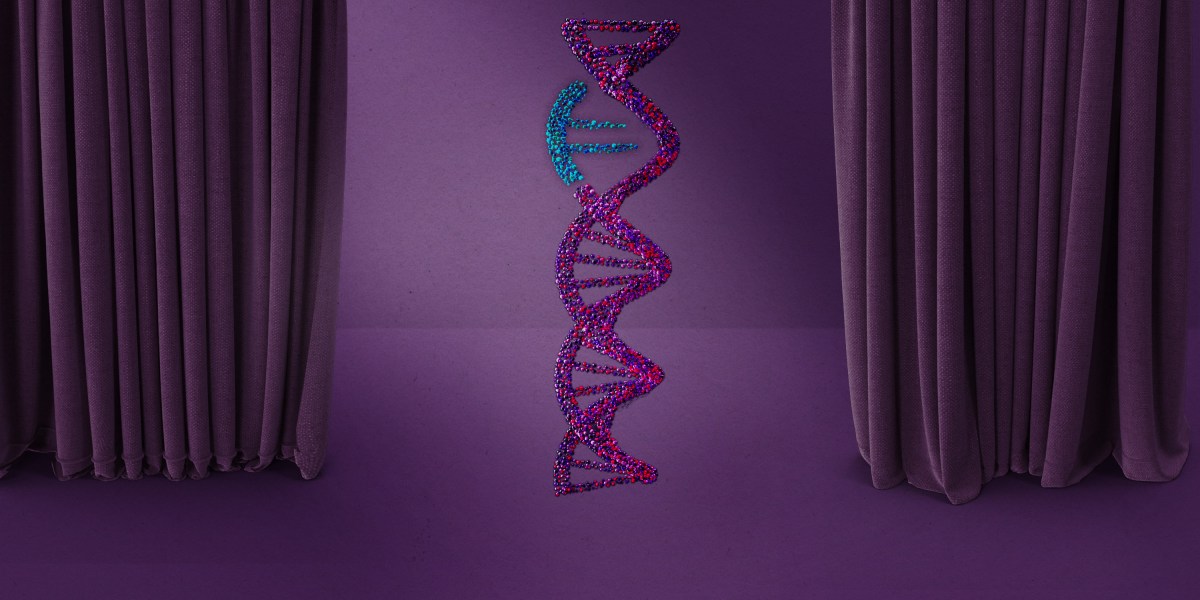Gene editing had a banner year in 2023
This article first appeared in The Checkup, MIT Technology Review’s weekly biotech newsletter. To receive it in your inbox every Thursday, and read articles like this first, sign up here.
Welcome back to The Checkup. This will be our last issue of 2023, so this week I’ve been reflecting on our biotechnology coverage over the past year. As I scrolled through our archives, I was struck by the vast number of stories we wrote about gene editing.
It really shouldn’t have come as a surprise. Perhaps no technology has more power to transform medicine, and its vast potential is just beginning to be realized. Gene editing can be used to delete, insert, or alter portions of our genetic code. We’ve been able to modify DNA for years, but newer technologies like CRISPR mean that we can do it faster, more accurately, and more efficiently than ever before. In 2023, we saw the first approval of a CRISPR-based gene-editing therapy. And many more are to come. So let’s take a look at the developments that made news this year. What is the promise of gene editing, and what are the current pitfalls?
Lucky breaks and next steps
Casgevy, the first CRISPR therapy, has already been approved in the UK and US to treat sickle-cell disease. And it’s now on the cusp of approval in the European Union. Sickle-cell disease is caused by a mutation in the hemoglobin gene that leads to a characteristic crescent moon shape of the red blood cells. The treatment doesn’t address the underlying cause of the disease; instead, it disables another gene, one that hampers production of a type of hemoglobin that people normally produce only in the womb and as babies. With that gene out of commission, production of this second type of hemoglobin resumes. The therapy works because cells with fetal hemoglobin won’t form sickles. You can read more about the fascinating backstory on the development of Casgevy in this story by my colleague Antonio Regalado.
Why go at it in this roundabout way? Current versions of CRISPR work best as a pair of scissors, creating snips that disable genes. That limits its usefulness. New versions of CRISPR will allow researchers to alter the genetic code or even insert new genes, which will make it possible to address a wide variety of genetic diseases.
Verve Therapeutics, for example, is testing an approach called base editing. Jessica Hamzelou covered this technique in depth in this story in January: “There are four DNA bases: A, T, C, and G. Instead of cutting the DNA, CRISPR 2.0 machinery can convert one base letter into another. Base editing can swap a C for a T, or an A for a G.” According to Kiran Musunuru, cofounder and senior scientific advisor at Verve, “It’s no longer acting like scissors, but more like a pencil and eraser.”
Verve’s therapy, now being tested in a small clinical trial, swaps out a single base in a gene for a protein called PCSK9, which is linked to high cholesterol. (The therapy was one of MIT Technology Review’s 10 Breakthrough Technologies 2023.) That change disables the gene, which means that the body makes less PCSK9 and cholesterol levels fall. In November the company announced interim results: a single injection of the therapy reduced LDL levels in the blood by up to 55% in 10 people with a genetic condition that causes high cholesterol.
CRISPR 3.0, which allows scientists to replace bits of DNA or insert new chunks of genetic code, is still being tested in animals. One company, Prime Medicine, plans to seek FDA approval to launch a human trial of a treatment for chronic granulomatous disease, a genetic immune disorder, in 2024 .
Pitfalls remain, at least for now.
The only approved CRISPR therapy isn’t a simple fix. Patients have to undergo a bone-marrow transplant: after chemotherapy to destroy their faulty cells, stem cells are extracted, edited in the lab, and then reinfused. Jimi Olaghere, one of the few people to have received the therapy, wrote about how arduous this was. The cell collection process left him so weak he needed blood transfusions. And the chemo meant “dealing with nausea, weakness, hair loss, debilitating mouth sores, and the risk of exacerbating the underlying condition.” All told, he spent 17 weeks in the hospital.
Given the complexity of the treatment, you won’t be surprised to learn that it’s expensive—it costs an estimated $2.2 million. That price tag means it’s out of reach for many, especially people in low-income countries.
Vertex is already exploring strategies to make sickle-cell therapies more accessible and affordable. Antonio spoke to the company’s head of research, David Altshuler, about some of the strategies earlier this month. One of the more promising approaches might not involve gene editing at all.
“One question I get a lot is: How are we going to get to the rest of the world?” Altshuler said. “And I think the answer is not by trying to do bone-marrow transplants in the rest of the world. It’s just too resource intensive, and the infrastructure is not there. I think the goal will be achieved sooner by finding another modality, like a pill that can be distributed much more effectively.”
Safety concerns abound. Gene editing is permanent, and one of the biggest concerns is that these therapies might miss the mark and create “off-target” effects. Regulators were so concerned about this possibility that an FDA advisory committee met in November to assess whether Vertex would need to provide additional data to prove Casgevy’s safety. (They ultimately decided the existing data was sufficient for approval.) The company plans to follow up with patients for 15 years to confirm safety.
Most experts think base editing, which doesn’t involve snipping, should be safer than the CRISPR scissors. But even there, safety has been front and center in discussions. The positive results in Verve’s trial of base editing to treat high cholesterol were partly overshadowed by the fact that two participants had heart attacks, and one of them died.
The epic patent dispute over CRISPR has long been another potential hiccup for possible therapies. But this month Antonio reported on a partial resolution. Vertex agreed to pay tens of millions of dollars to competitor Editas and the Broad Institute for the right to use Broad’s CRISPR patent, thus avoiding a potential lawsuit. “It’s not yet clear if the license agreement points to an end of the fierce patent fight between Broad and Berkeley. That has been continuing before a US patent court, with Berkeley still trying to overturn its rival’s claims,” he wrote.
Despite the pitfalls, it’s clear that gene-editing therapies, when they work, can be transformational. Olaghere detailed his experience as a trial participant. “I started to experience things I had only dreamed of: boundless energy and the ability to recover by merely sleeping. My physical symptoms—including a yellowish tint in my eyes caused by the rapid breakdown of malfunctioning red blood cells—virtually disappeared overnight,” he wrote. “Most significantly, I gained the confidence that sickle-cell disease won’t take me away from my family, and a sense of control over my own destiny.”
Another thing
- Hunter-gatherer societies may still retain many of the microbes that people living in industrialized societies lack. That’s why scientists are racing to catalog their microbiome. But there’s a catch, writes senior reporter Jessica Hamzelou. “We don’t know whether those in hunter-gatherer societies really do have ‘healthier’ microbiomes—and if they do, whether the benefits could be shared with others.” What’s more, members of these communities say some research is being conducted without regard for ethics or equity. “Taking advantage of an Indigenous population and using their microbes to try to reinstate health in somebody from a wealthy, industrialized nation, I think, is a problematic thing to do,” Justin Sonnenburg, a microbiome scientist at Stanford University, told her.
From around the web
- A New York Times investigation delves into the increasingly popular practice of snipping “tongue-ties” in babies, an often unnecessary procedure being aggressively pushed by some lactation consultants and dentists. A heartbreaking must-read. (NYT)
- Studies call into question the benefit of spinal cord stimulation for pain (Medpage)
- Researchers are testing a new non-hormonal male birth control pill in a clinical trial in the UK.. (Stat)
- Chemotherapy drug shortages are robbing cancer patients of the therapies they desperately need and highlighting systemic problems in the generic drug market. (NYT) But there are some possible fixes. (NYT)
- The high lead levels in some applesauce pouches, which sickened more than 100 children in the US, came from the cinnamon that was added. Regulators are still trying to work out why the cinnamon contained lead. (Washington Post)




